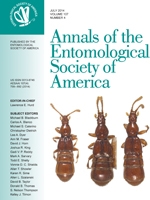Habrobracon hebetor Say (Hymenoptera: Braconidae) is a gregarious ecto-parasitoid that attacks larvae of several species of Lepidoptera, mainly pyralid moths infesting stored products. Host quality strongly influences the reproductive success of the parasitoid. In this study, we assessed the reproductive performance of the parasitoid, H. hebetor in a series of laboratory experiments using six different pyralid host species: Indianmeal moth, Plodia interpunctella (Hübner), Mediterranean flour moth, Ephestia kuehniella (Zeller), almond moth, Ephestia cautella (Walker), rice moth, Corcyra cephalonica (Stainton), navel orangeworm, Amyelois transitella (Walker), and greater wax moth, Galleria mellonella L. Experiments were conducted using petri dishes (100 by 15 mm) as experimental arenas at 29 ± 1°C, 65 ± 5% relative humidity, and a photoperiod of 14:10 (L:D) h. Two-day-old H. hebetor females were introduced singly into experimental arenas and given a single host larva every day throughout their lifetime. The numbers of hosts paralyzed and parasitized, numbers of eggs laid each day on each host, egg-to-adult survivorship, and progeny sex ratio were used as parameters for assessing host suitability. Paralysis of hosts by H. hebetor females was significantly affected by host species. H. hebetor paralyzed >95% of the preferred host larvae that were offered and also used ≈90% of those for oviposition. Daily fecundity was highest on G. mellonella (22.1 ± 0.4) and C. cephalonica (21.6 ± 0.3), and lowest on E. cautella (13.4 ± 0.2). The egg-to-adult survivorship and progeny sex ratio were also significantly affected by the host species. The highest percentage of parasitoid survival was on A. transitella (75.7 ± 2.0) and C. cephalonica (75.4 ± 2.5), and lowest on G. mellonella (49.7 ± 4.8). Our studies clearly showed that H. hebetor females can paralyze and lay eggs on several pyralid species, but it cannot necessarily develop and reproduce optimally on all host species that it can paralyze and parasitize.
How to translate text using browser tools
1 July 2014
Oviposition and Reproductive Performance of Habrobracon hebetor (Hymenoptera: Braconidae) on Six Different Pyralid Host Species
Mukti N. Ghimire,
Thomas W. Phillips
ACCESS THE FULL ARTICLE
It is not available for individual sale.
This article is only available to subscribers.
It is not available for individual sale.
It is not available for individual sale.
biological control
host quality
parasitoid
reproduction
stored-product pest





